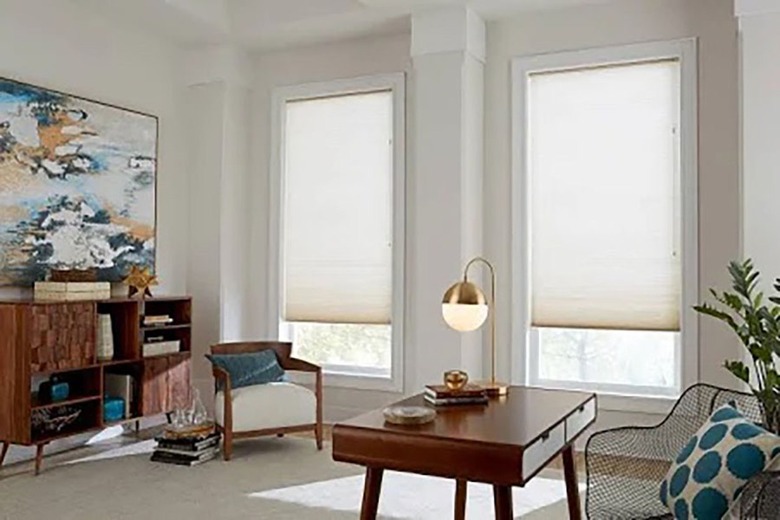How To Clean Cellular Shades In 4 Easy Steps
If you're looking for window treatments that also provide insulation, cellular shades are a great way to go, especially if you want to keep things as simple as possible. Also known as honeycomb shades, cellular shades feature multiple layers of fabric that form cells when the shades are closed, and the air in the cells provides an effective barrier to heat transfer. Cellular shade are not quite as effective at insulating as a heavy curtain or drapes, but shades come without all the extra fabric and a potential loss of natural light in the room.
Cellular shades provide an insulating layer of air between the window and the inside surface of the fabric from which they are fashioned. They are more energy efficient than many heavier window coverings, including wood and faux-wood blinds, they allow more light into the room when they're closed, and cleaning them is usually a simple DIY task.
How to Clean Cellular Shades
How to Clean Cellular Shades
You might have a few small challenges when you clean cellular shades because, depending on the fabric, the pleats may lose their shape if they get wet. Plus, the cells themselves can collect debris inside them, including dust and dead insects. This isn't to say you can't use water, but as a general rule, you should do so sparingly and only when recommended by the manufacturer. Most cleaning tasks don't use water and can be completed with a duster, vacuum cleaner, and forced air.
1. Clean Off the Dust
Because they are made of cotton, polyester fabric, or a similar material, cellular shades are a magnet for dust, and if you don't clean them regularly, they can become dingy and discolored. All you need to do to prevent this is to clean off the dust buildup every few weeks, and the best way is to use a vacuum cleaner with a soft brush attachment. Close the shades and then run the brush lengthwise along the cells, working your way from the top to the bottom.
Some dirt may not come off with the vacuum, so you may also have to go over them with a feather duster. If you have pets, you may find that pet hair clings to the fibers more tightly than dust and doesn't come off even when you use the duster briskly. Remove these by wiping with a clean cloth or better yet, use a lint brush. Pull down the bottom of the shade gently to tighten the fabric and then run the lint brush gently across the surface. No pet hair can resist this treatment.
If you have vertical blinds, the procedure is pretty much the same except you have to run the vacuum cleaner and dusting tools vertically along the cells rather than horizontally. Don't forget to close the blinds all the way to make sure that dirt doesn't find a hiding place inside the pleats.
2. Get Debris Out of the Cells
Cellular shades can be fabricated with one, two, or three individual cells per pleat, and these are great hiding places for flies and other insects that frequently die there. Nothing ruins the clean look of translucent shades more than the silhouettes of dead bugs, but they are easier to remove than you might think. However, one thing you don't want to do is poke inside the cells with a long object because that's just inviting tears and damaged pleats.
The best way to remove debris from inside the cells is to blow it out with forced air. If you have a can of compressed air, you can use that, but if you don't, a hair dryer will also work. Just be sure it's on a low setting at the coolest temperature because excessive airflow may tear the fabric, and heat can damage the adhesive holding the fabric together. If you're removing a lot of insect carcasses and other debris, you might want to put a drop cloth on the opposite side of the shade while you're blowing to make cleanup easier.
3. Spot Clean to Remove Stains
Stains happen, and when they happen to cellular shades, they're more noticeable than in other places. In fact, they often appear front and center when light passes through the translucent window coverings and emphasizes the color differences. The temptation is to grab a wet cloth and wipe them off, but that's more likely to spread a stain than it is to remove it.
To clean honeycomb shades, the first thing you need to do is check the label or the product owner's guide for the manufacturer's cleaning recommendations and follow them exactly. It may specify using water only because any type of detergent, even a mild one, can discolor the fabric. If there are no manufacturer's recommendations, it's still a good idea to try a damp cloth before resorting to any type of soapy solution.
Moisten a microfiber cloth with warm water to make it damp, not wet, and dab the spot repeatedly. If you successfully remove the stain, leave the shade down until the spot dries. If you need a soapy solution and the manufacturer doesn't caution against using one, mix a quart of warm water with a few drops of dish soap and use that to moisten the cloth. Wring the cloth well and dab the spot. If you get it off, dab again with a damp cloth to remove the soap.
4. Deep Clean When Necessary
The issue of whether you can wash cellular shades is controversial. Some sources say you shouldn't do it under any circumstances, while others say washing is OK as long as the manufacturer doesn't warn you against it. The manufacturer's instructions usually specify whether the shades are washable or not, but if you've lost the instructions, it's probably best to have your soiled shades professionally cleaned. The pros use a special cleaning solution and a device that generates high-frequency sound waves to coax dirt out of the fibers.
If you decide to risk a DIY washing job, always use cold water mixed with a little mild detergent or dish soap. Take the shades off the headrail and remove as much hardware as you can. Then, dip the shades in the soap solution long enough for the water to work its way through all the cells. Lay the shades on towels or hang them to let them air dry. Never put them in the dryer for the same reason you wouldn't put a wool sweater in the dryer: The heat and agitation will shrink the fabric.
If you have cellular shades hanging in the kitchen where grease and oil fly through the air, you may not be able to deep clean them thoroughly by washing them in cold water (assuming your shades are washable). In that case, you need professional cleaning. It's likely to cost anywhere from $18 to $45 per shade (depending on shade width) to have a pro come to your house and do an ultrasonic cleaning.

